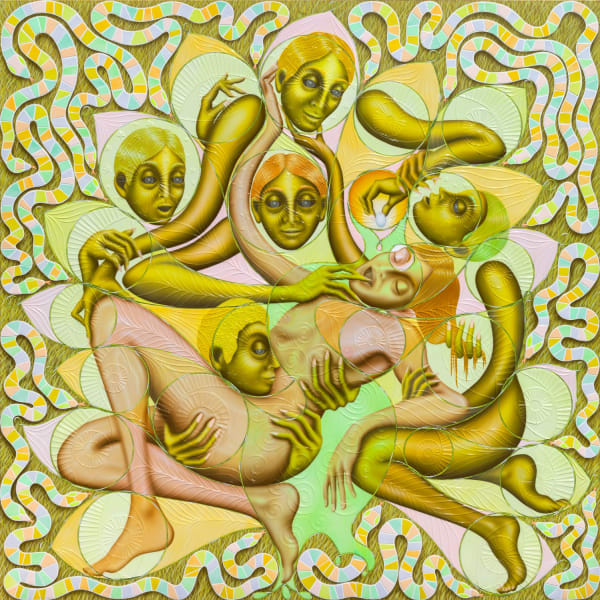Wendell Gladstone: Safe Haven
Shulamit Nazarian is pleased to present Safe Haven, a series of new paintings by Los Angeles-based Wendell Gladstone. This will be the artist’s second solo exhibition with the gallery.
The new paintings in Safe Haven continue the artist’s interest in surreal and psychologically charged spaces, often populated with a cast of humans, animals, and hybrid forms. Expanding upon the idea of a ‘haven’, or a place of refuge, this exhibition conjures the varying degrees in which tenderness and precariousness overlap. Binaries blur between intermingled bodies—what is understood as interior and exterior, bound and liberated, giving and receiving, fluidly shift within a single work. This series examines an unfolding relationship between human connection, power, and safety through notions of gazing and physical contact.
Transparent layers of paint function as windows, bringing the physical materiality of the paint and the idea of painting-as-window to the surface, allowing the viewer to literally see through one layer and into the next. Portals of implied stained-glass invoke religious connotations, adding to the celestial and other-worldly nature of the paintings, while deftly manipulated flat blocks of color provide a low relief-like dimensionality. At times mimicking mosaic, terrazzo, or concrete, the artist’s skillful sculptural painting technique can just as easily render ghost-like forms and subtle textures only made visible by certain angles of light. This process allows two different scenes to exist simultaneously on a single plane, effortlessly alternating between opposing weights and mass to create an uneasiness––as if the image could slide right off the canvas.
In paintings such as Double Dutch and Support System, the figures’ long malleable limbs are tied together arduously, propped up as much as they are weighed down. Each inhabitant’s struggle becomes an integral part to completing the cyclical nature of the artwork; as if a single quiver of the muscles could cause a compositional collapse. The hierarchal struggle amongst the cast of characters often rests on the tips of toes and fingers, evoking a taught embrace that could slip away at any moment. Repeated limbs and faces are frozen in a frenzy of motion—like a Grecian frieze. The heaviness of each figure seems to defy the impending force of gravity as they levitate on groundless hues of pale green, blue and yellow.
In contrast, paintings such as Perch and The Lookout are spaces that at first glance seem naturalistic. Figures climbing trees in the foreground peer at unwitting couples in the background; lions on the periphery study the subject in the center. These paintings have a defined sense of space and the narrative between characters focuses on gaze rather than touch. The psychological tension derives in part from their ambiguous relationship to one another. It is unclear whether characters pursue, stalk, or flirt; or if they are seeking safety from the dangers of the outside world, as refuge and peril oscillate endlessly. Figures stare longingly at each other while crabs, snakes, and cats hide in the perimeters throughout the exhibition, reminding the viewer to scan their own environment of potential threats.
In Safe Haven, animals can simultaneously give respite, as seen in the groups of figures which occupy their zoomorphic forms in cramped, cocoon-like ways. Bulls, horses, and peacocks provide an armature for the figures inside, imitating the psyche of its inhabitants. A stretched, elongated figure referencing Michaelangelo’s Pietàis resuscitated by its surrounding care givers, who breathe life into the central figure—mimicking the expanding wings of a peacock. In Tip of the Hat With the Wind at My Back, a dancing couple is enveloped by the shape of a raging bull, the dip of one partner echoing the kicking motion of the animal. Patterned clothing and bow-tied shoes referencing the regalia of toreros, or bullfighters from Spain, adorn the violent twirl between the two.
Following a decade of work, SafeHaven expands the artist’s interest in figurative painting that evokes the space between logic and dreams. Utilizing a large swath of references that span eras and cultures, these paintings call forth historical allegories to touch on contemporary subjects of isolation, power, connection, and instability. Giving license to his subconscious to guide the narratives and structure, the paintings allow for Jungian archetypes and parables of the past to mix with the artist’s personal experience and the zeitgeists of today—culminating in a body of work which shifts mythologically into the present and champions the potential for lucidity to provide a sense of clarity
in unsettling times.
-
 Wendell GladstoneHand in Hand, 2020Acrylic on canvas39 x 39 inches
Wendell GladstoneHand in Hand, 2020Acrylic on canvas39 x 39 inches -
 Wendell GladstoneBubble Up, 2020Acrylic on canvas39 x 39 inches
Wendell GladstoneBubble Up, 2020Acrylic on canvas39 x 39 inches -
 Wendell GladstoneMain Squeeze, 2020Acrylic on canvas39 x 39 inches
Wendell GladstoneMain Squeeze, 2020Acrylic on canvas39 x 39 inches -
 Wendell GladstoneSupport System, 2020Acrylic on canvas90 x 66 inches
Wendell GladstoneSupport System, 2020Acrylic on canvas90 x 66 inches -
 Wendell GladstoneDon Hoffman’s Desktop, 2020Acrylic on canvas84 x 62 inches
Wendell GladstoneDon Hoffman’s Desktop, 2020Acrylic on canvas84 x 62 inches -
 Wendell GladstonePeacock, 2020Acrylic on canvas84 x 84 inches
Wendell GladstonePeacock, 2020Acrylic on canvas84 x 84 inches -
 Wendell GladstoneDouble Dutch, 2020Acrylic on canvas84 x 84 inches
Wendell GladstoneDouble Dutch, 2020Acrylic on canvas84 x 84 inches -
 Wendell Gladstone, The Lookout, 2020
Wendell Gladstone, The Lookout, 2020 -
 Wendell GladstoneSquall, 2020Acrylic on canvas84 x 62 inches
Wendell GladstoneSquall, 2020Acrylic on canvas84 x 62 inches -
 Wendell GladstoneUndertow, 2019Acrylic on canvas89 x 68 inches
Wendell GladstoneUndertow, 2019Acrylic on canvas89 x 68 inches















